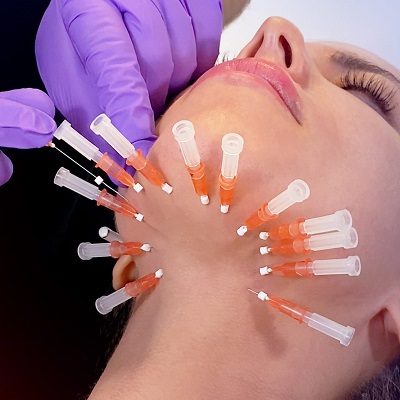
Thread lift is a popular and less invasive method to tighten and raise sagging skin. Moreover, this process is a fast approach to appear better without surgery. Furthermore, the correct treatment guidelines are crucial for the best outcomes. In addition, this process has a shorter recovery period than conventional facelifts. However, you may ask if I Eat Normally After Thread Lift. Hence, this blog will cover all in this blog.
What is a Thread Lift?
Without surgery, a thread lift tightens and raises the skin on your face, neck, or chin. Your plastic surgeon will thread dissolving beneath the skin to support and elevate the drooping sections during the surgery. Usually composed of polydioxanone (PDO) ingredients, these threads enable the body to naturally over time thicken the skin and produce more collagen.
Usually spanning thirty minutes to an hour, this rather intrusive procedure may be completed quickly. Extensive incisions are unnecessary, and recovery is much shorter than after a standard facelift. Thread lifts have gained popularity among those who want to seem younger without undergoing surgery or a protracted recovery period.
Can I Eat Normally After Thread Lift?
If you are worried about having the question, “Can I Eat Normally After Thread Lift?” Indeed, you are free to consume after a thread lift; yet, you need to make certain adjustments throughout your healing period. Although eating is typically OK, you should keep a few things in mind to ensure you do not interfere with the healing process and have the best potential outcomes.
Precautions While Eating after Thread Lift:
These are the primary why you could find yourself needing to alter your diet after a thread lift:
- Swelling and Tenderness: The treated region might feel swollen or uncomfortable after treatment. For more challenging items specifically, this might make eating difficult.
- Thread Stability: Certain meals or eating patterns can cause the threads to lose stability. For example, particularly with facial thread lifts, eating fast or pushing down too forcefully on food might loosen the threads.
- Healing Process: Maintaining a treatment region from becoming too stressed is the aim during the healing phase. Eating soft meals can help you avoid worrying about the threads excessively, allowing the skin to recover correctly and ensuring you have the most remarkable results.
Foods You Should Avoid After A Thread Lift:
You should avoid meals that can damage or disturb the treatment regions around one week after your thread lift. Here is a list of items you should steer clear of when recovering:
- Hard or Crunchy Foods: Nuts, chips, raw vegetables, and firm fruits might strain the treatment area and increase the likelihood that the threads will break free.
- Chewy Foods: Steak, gum, and sticky sweets are chewy foods that require extensive chewing. They may exert too much strain on the face, which would be uncomfortable and difficult to swallow.
- Hot or Spicy Foods: These meals might disturb the treated regions and cause more swelling or pain. Furthermore, causing redness and edema are spicy meals.
Recommended Foods for Easy Recovery:
Eat soft, easy-to-chew meals, especially in the days after a thread lift. These items ease the healing process and prevent the treatment sites from becoming very painful. The following is a list of items ideal for skin during healing:
- Soups and Broths: Easy to consume and packed with nutrients, soups, and broths prevent chewing too much. Select moderate meals free of heat to avoid pain.
- Mashed Potatoes: Mashed potatoes and sweet, creamy potatoes are easy to chew and an excellent source of carbohydrates for energy.
- Yogurt and Smoothies: Perfect for your face, yogurt and smoothies are cold and silky. These meals provide vital nutrients and help you stay hydrated.
- Scrambled Eggs: High in energy and simple to consume without stressing the treatment region excessively, soft, fluffy scrambled eggs
- Soft Fruits: Applesauce, bananas, and mangoes are soft fruits that are simple to chew and packed with nutrients and vitamins to help the body recover.
How Long Should I Avoid Certain Foods?
You should avoid meals that are spicy, chewy, or hard, at least seven to ten days after your thread lift. This allows the threads to settle in and reduces their likelihood of coming free. You may gradually resume your regular diet after this period, but first you should always check with your doctor.
Final Thoughts:
After a thread lift, it is okay to eat; still, eating carefully during the first few days may help your outcomes to be much better. Choosing soft, easy-to-chew meals and avoiding anything that can irritate or damage the treatment areas will help you to ensure more seamless recovery. Following the treatment directions your surgeon provides will also help your body repair, therefore providing you with a new, youthful appearance that lasts. Remember also that the degree of your facial care after the procedure is equally crucial as the therapy itself.
Book your appointment at Dynamic Clinic PK for the most effective and long-lasting thread lift in Islamabad, Pakistan.




